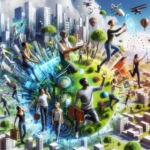Mastering Object Duplication Technology in Quest 3 Mixed Reality
Introduction to Mixed Reality and Object Duplication Technology
Mixed reality technology offers thrilling opportunities, merging digital and physical realms into a cohesive experience. With revolutionary devices like Quest 3, developers have the chance to create immersive environments that engage users like never before. Central to this innovation is object duplication technology, showcasing extraordinary advancements. This blog post examines how a developer has adeptly managed the complexities involved in this fascinating domain.
Understanding Object Duplication Technology
To grasp object duplication technology, it’s essential to know what it encompasses. Essentially, it allows for the replication of physical objects within a virtual atmosphere. This astonishing process employs sensors and cameras to capture various aspects of the object, including dimensions, shape, and texture.
By converting these tangible features into digital formats, developers gain the ability to construct precise virtual models that users can actively engage with. The scope of applications is extensive, spanning gaming, education, healthcare, and much more.
Challenges in Implementing Object Duplication Technology
Although object duplication may appear straightforward, developers face multiple challenges during the implementation phase:
- Accuracy: It’s vital to ensure the digital depiction corresponds precisely to the physical object. Any discrepancies may lead to user dissatisfaction and hinder immersion.
- Data Processing: The large volume of data from 3D scans demands powerful processing capabilities. Developers must optimize this information to sustain performance.
- User Experience: Crafting an intuitive interface that allows users to interact smoothly with duplicated objects can be challenging. Developers must strike a balance between functionality and usability.
The Developer’s Innovative Approach
The developer in focus adopted a distinctive strategy for tackling these challenges:
1. Leveraging Cutting-Edge Technology
By utilizing advanced sensors on Quest 3, the developer significantly improved the efficiency of data collection. This enhancement enabled quicker scans and greater accuracy in the representation of objects.
2. Emphasizing Iterative Testing
The developer highlighted the necessity of thorough testing. Through a cycle of repeated trials and modifications, they successfully fine-tuned the duplication process. This rigorous approach revealed technical issues and elevated the overall user experience.
3. Incorporating User Feedback
Integrating insights from beta testers played a crucial role in refining object duplication technology. By analyzing user interactions, the developer made essential adjustments, ensuring the final product aligned with user expectations.
Advantages of Proficient Object Duplication Technology
Mastering this groundbreaking technology yields numerous benefits:
- Increased User Engagement: Users can explore and interact with their surroundings in more dynamic ways, enhancing overall engagement.
- Enhanced Educational Methods: Educators can leverage object duplication technology to design interactive lessons, which promotes better understanding and retention.
- Innovative Opportunities: From immersive gaming to virtual tours, object duplication opens the door to transformative experiences that alter how we interact with digital and physical realms.
Future of Object Duplication Technology
The progress made in mixed reality and object duplication technology may lead to groundbreaking developments across various sectors:
- Revolutionizing Retail: Consumers might soon be able to replicate products within their home environment, enhancing the shopping experience.
- Transforming Art and Design: Artists could devise installations where viewers engage with virtual components replicating physical artworks, pushing the limits of creativity.
- Redefining Architecture: Architects may apply object duplication to visualize buildings in real-world contexts, improving planning and design workflows.
Conclusion
The pursuit of mastering object duplication technology in mixed reality, particularly through platforms like Quest 3, illustrates the remarkable blend of technology and creativity. As developers forge ahead with innovation, the opportunities for immersive experiences multiply, setting the stage for a thrilling future in mixed reality applications.




0 Comments